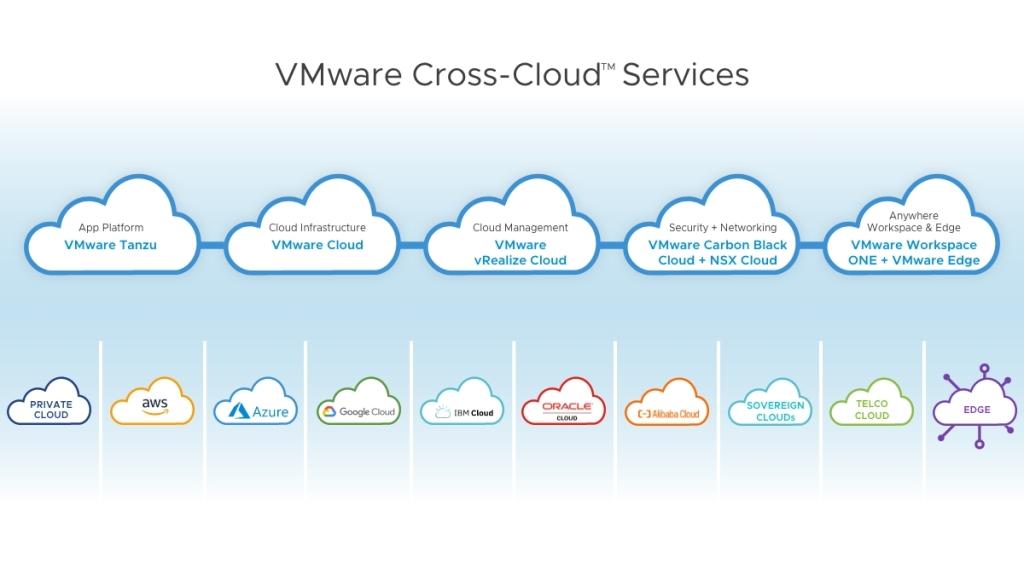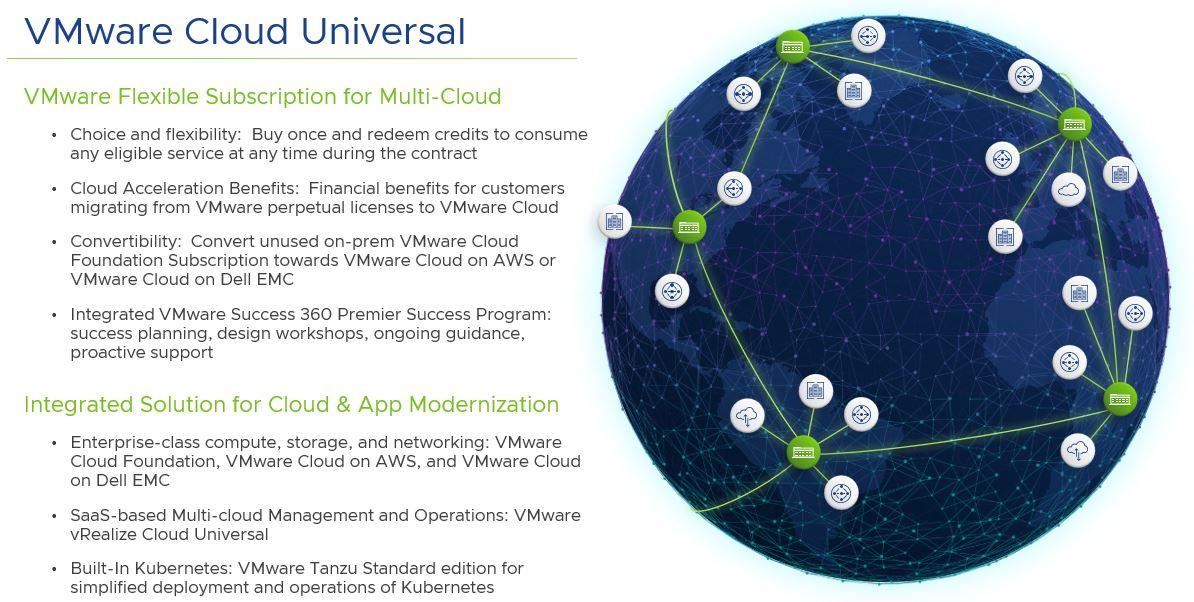Following a year that the world will remember for a long time to come (and mostly not for good reasons), we wrap up 2021 with a plethora of events happening in the tech industry. In the meantime, we certainly hope that you are doing well and staying safe during this upcoming festive period. In this article, we’ll recap the most important VMware news stories of the year and have a look ahead at what 2022 has in store. Let’s get going!
Company Growth
A lot has been going on this year in the VMware space, not only in a technical aspect but also with major changes within the company’s structure and management.
Financially, the company keeps doing very well with projected revenue of over $12.8 billion, an increase of around 9% compared to last year with expected significant growth in the SaaS area.
One of the axes VMware is also working on to generate revenue is the partner incentives program based on the customer life cycle. The new incentives reward partners that deliver PoCs, customers’ assessments and “sell-through” partners working together.
Acquisitions
VMware acquired a dizzying number of companies over the course of the previous year (2020). However, mergers are time-consuming and are never straightforward when it comes to restructuring teams, merging products into existing portfolios… VMware has put a lot of resources into integrating previous years’ acquisitions into their existing portfolios such as Carbon Black, Salt or Datrium.
This might be the reason why they only acquired one company in 2021 with Mesh7. Let’s have a closer look at what it is.
Mesh7
VMware acquired Mesh7 at the end of the first quarter of 2021. Their technology helps customers improve application resiliency, reliability and reduce blind spots through the integration of deep Layer 7 insights with cloud, host, and reputation data. They offer a distributed API Security Mesh solution (API Firewall and API Gateway) which is focused on securing the application layer at its core in Kubernetes environments.

VMware acquired Mesh7 at the end of March 2021 to further secure Tanzu Service Mesh
VMware uses Envoy as an open-source Layer 7 proxy in Tanzu Service Mesh and Mesh7’s API gateway is being integrated into the solution to further secure the Kubernetes connectivity solution.
VMworld 2021
As usual, let’s quickly recap what happened during VMworld 2021 which was, once again, a virtual event. We will only skim over the surface of what was announced as a lot of other areas were covered such as Security, Networking, End-User services… For more information about the announcements made during this event, head over to our dedicated VMworld 2021 Round-up Article.
Strong focus on multi-cloud
VMware followed the trend set in the previous year with a strong push towards multi-cloud and managed cloud services. VMware Cross-Cloud services will offer a bunch of multi-cloud services you can pick and choose from in a flexible manner to facilitate and accelerate customers’ adoption.

“VMware Cross-Cloud services aims at simplifying the shift to a multi-cloud SDDC”
VMware Sovereign Cloud tackles the issues around how sensitive data is dealt with through partnerships with Cloud providers. The goal is to offer those public entities and large organizations a data sovereignty seal of approval in a multi-cloud world.
Other announcements in the Cloud space included VMware Cloud on AWS Outpost and improvements to the disaster recovery as a service (DRaaS) offering.
Tanzu gets ever closer to maturity
VMware Tanzu, the company’s implementation of Kubernetes is being built upon ever since the portfolio was announced at VMworld 2019. The big reveal of this year’s event was Tanzu Community Edition, a free and open-source release of the solution aimed at learners and users.
Other Tanzu related announcements included VMware Cloud with Tanzu Services, managed Tanzu Kubernetes Grid (TKG), Tanzu Mission Control Essentials and a free tier with Tanzu mission control Starter.

“VMware Tanzu Community Edition is full-featured but free and open-source”
Lots of projects in development
VMware always has a bunch of projects with codenames in the works that later become actual products when they reached maturity. Remember how Tanzu used to be known as Project Pacific. In 2021, the company revealed no less than 9 major projects in various areas such as Edge computing, AI/ML, Security, multi-cloud, tiered memory for vSphere, Kubernetes…
Again, you can find the details about these projects in our VMworld 2021 roundup.
Edge Computing
The other area that was largely covered was Edge computing with the announcement of VMware Edge Compute Stack, a purpose-built and integrated stack offering HCI and SDN for small-scale VM and container workloads to effectively extend your SDDC to the Edge.

“VMware Edge compute Stack helps solve use cases for a wide variety of challenges”
While a lot of good things went their way, 2021 was an eventful year for VMware. Several big announcements were made that will change the face of the company and a few vSphere related crises the company’s TAMs had to navigate.
VMware and DellEMC Split
Probably the biggest announcement of the year was the split from DellEMC which was the majority stakeholder with 81% shares in the company. This separation comes 5 years after Dell acquired EMC in September of 2016 for a whopping $67 billion, EMC being VMware’s controlling stakeholder at the time. On November 1st 2021, VMware becomes a standalone company for the first time since EMC acquired it in 2004, albeit after paying $11.5 billion in dividends to the shareholders.
In a news article, VMware’s new CEO Raghu Raghuram (more on that later) officialized the split and kept emphasizing their multi-cloud strategy with the goal of becoming “the Switzerland of the cloud industry”:
“As a standalone company, we now have the flexibility to partner even more deeply with all cloud and on-premises infrastructure companies to create a better foundation that drives results for our customers. And the increased flexibility we will have to use equity to complete future acquisitions will help us remain competitive. “
VMware has a new CEO
A number of top officers over at VMware left the building and were replaced by new top profiles. Among those, we find the CEO of the company himself. Pat Gelsinger, who led VMware between 2012 and 2021 gave his notice in February to become Intel’s new CEO after spending 30 years as a top profile between 1979 and 2009 for the blue team, a very impressive resume if you ask me.
VMware replaced him with Raghu Raghuram, the previous COO who’d been climbing up the corporate ladder since 2003, clocking over 18 years of employment to reach the top of the pyramid.

Raghu Raghuram succeeds to Pat Gelsinger as VMware’s CEO
vSphere 7 Update 3 removed
On a more technical note, 2021 was a rather turbulent year for vSphere 7.0. The year started with many customers encountering purple screens on vSphere hypervisors installed on SD cards or USB sticks, which eventually led VMware to pull support for these boot devices. This wasn’t received particularly well among the customer base as many were taken by surprise and now have to plan for it, which will be a large piece of work and investment depending on the size of the environment.
Following this shaky start, customers started having problems with vSphere 7 Update 3 causing PSOD in some instances. In order to fix it, VMware released patches that ended up breaking vSphere HA for many customers using a certain type of Intel adapters. VMware eventually decided to stop the haemorrhage by removing vSphere 7 Update 3 from distribution altogether, just over a month after its release.

“vSphere 7 Update 3 was crippled with issues since its initial release”
Needless to say that customers were pretty unhappy with how this unfolded. Many blamed the 6 months release cycle and quality control being put to the side in favor of shiny new Cloud or Tanzu features. Let’s hope the scission from DellEMC will entice VMware to regain a certain level of quality control and that organizations won’t put the deployment of security patches on hold as a result.
VMware Cloud Universal
As you can tell, VMware is very keen to push Cloud subscriptions to its customers and VMware Cloud Universal, which was released in April 2021, was another testimony of that. A subscription offering that offers access to multi-cloud resources, be it infrastructure, compute, storage, networking, modern apps…
The idea is to be able to flexibly deploy VMware Cloud Infrastructure across private and public clouds. VMware Cloud Universal includes VCF-Subscription (also released in 2021), VMware Cloud on AWS and VMware Cloud on DellEMC.
Now, I’ll admit that it is getting a bit tricky to make sense of the many cloud offerings proposed by VMware with VMC, VMC on AWS, VMware Cloud Universal, VMware Cross-Cloud services and then the subtleties in each one of them.

“VMware Cloud Universal allows customers to establish a flexible commercial agreement with VMware to commit once and consume dynamically”
Ransomware Attacks Targeting vSphere ESXi
In 2021, we, unfortunately, witnessed no curb in the infamous growing trend of vSphere Ransomware attacks. While most encrypting ransomware attacks were historically focused on Windows and Linux instances, vSphere is now being targeted as well. Bad actors will try to gain access to the virtual infrastructure and initiate encryption of the datastores to claim a ransom, hence impacting every single VMs in the environment.
Fortunately, most companies are now investing large amounts of resources to mitigate the risks and protect the customers, for instance, Altaro has been doing it for a long time now.
A Look Ahead to 2022
I wrapped up last year’s roundup with “Watch for 2021 as it is without a doubt that it will be a year packed with major events”. Well, I think it is safe to say that it turned out to be true. VMware’s split from DellEMC will give the company absolute autonomy over its market strategy and path to a multi-cloud world. 2022 will see a maturing of these core cloud technologies alongside VMware doubling down on its acquisition strategy of key technologies that will solidify its commitment to this direction.
While we are eager to find out what it brings in terms of novelties, we are equally looking forward to a return to a more sensible release cycle and the distribution of a stable version of the historic hypervisor (well that’s my main hope at least!) I’d love to hear your thoughts, so feel free to take your bet in the comment section as to what 2022 will bring!
Source :
https://www.altaro.com/vmware/2021-vmware-developments/